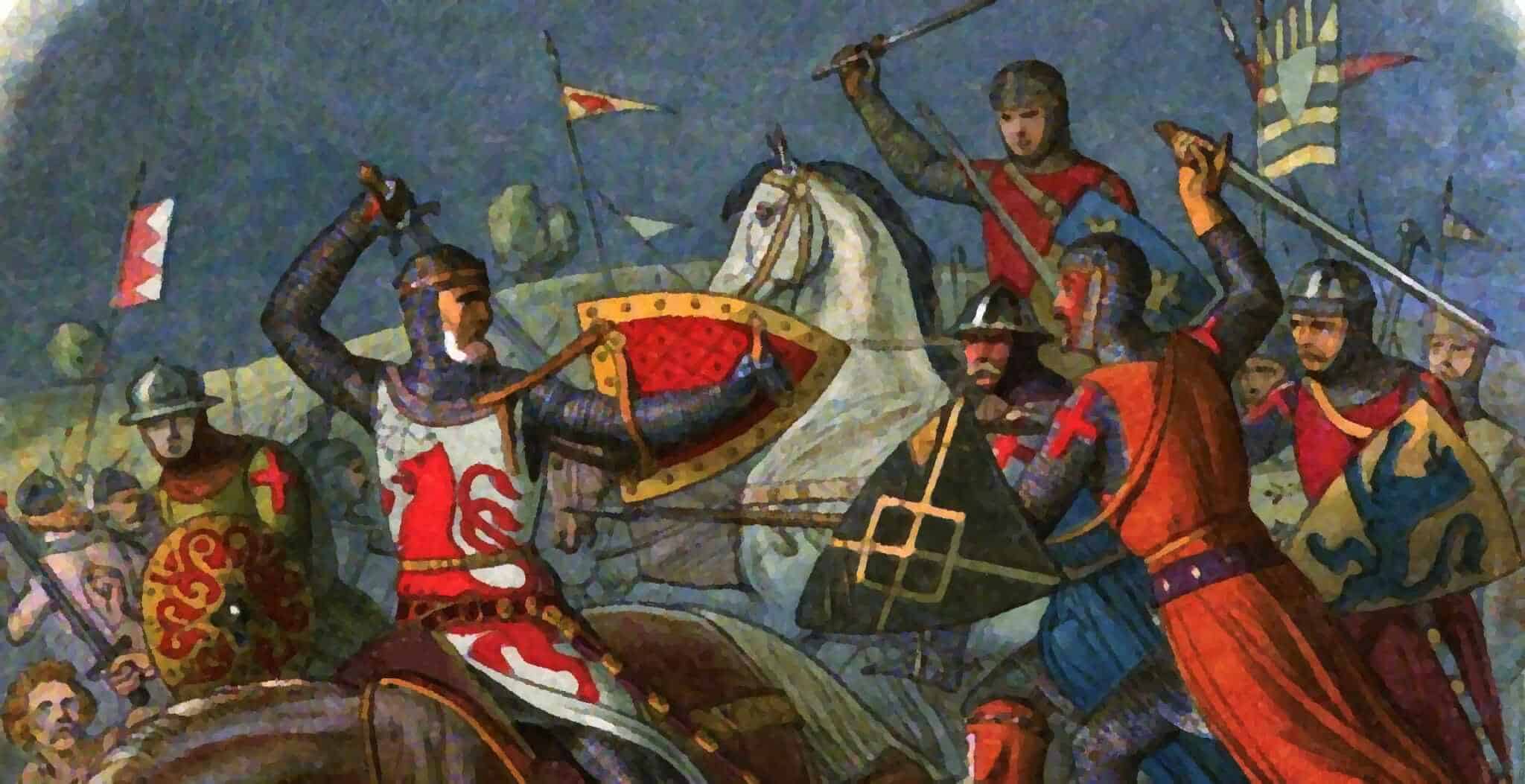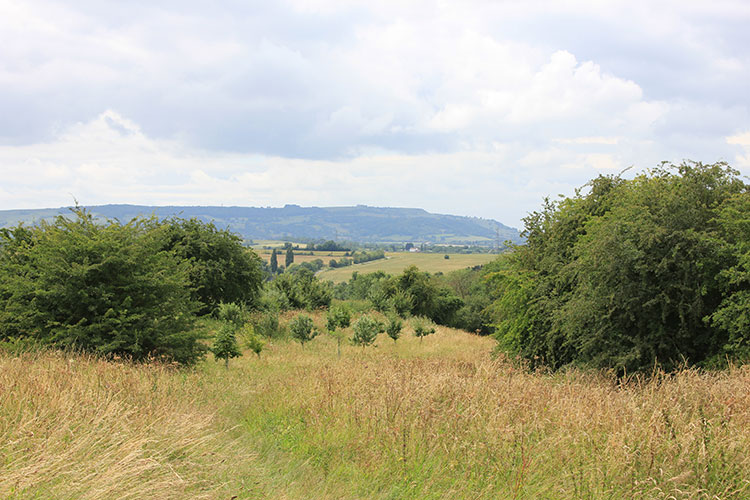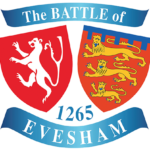HISTORY ROUND EVERY CORNER (AND UP THE HILL)
You don’t have to walk far from Bredon-Vale to stand in the heart of the ground that witnessed one of England’s bloodiest and most pivotal fights – the Battle of Evesham.
It took place beneath the rolling thunder of a storm on Tuesday, August 4, 1265. Here’s our brief(ish) guide to that momentous day….

Simon de Montfort about to meet his grisly fate on the battlefield. Image courtesy of the Battle of Evesham website.
WHAT WAS IT ALL ABOUT?
Well, we have to look back to 1215, when rebellious barons forced King John – buried in Worcester Cathedral, the year after – to sign the Magna Carta, a ‘great charter’ that listed things he promised not to do in the future.
The trouble was this. John believed that government was the monarch’s business, so he and his son – the future Henry III – simply chose to ignore the rules when it suited them.
John died in 1216, but it took until 1258 for Henry’s opponents to do something about it, and the opportunity came when he called a parliament – a large gathering of the royal court – that drew up a fresh list for him to follow.
A permanent council was established to supervise the appointment of royal officers.
WHO WAS SIMON DE MONTFORT?
Simon de Montfort was the 6th Earl of Leicester, a leading member of the council that stripped Henry of his powers in that so-called Oxford Parliament, and then called a second momentous parliament that included ordinary citizens from the towns – an historic act that explains why de Montfort’s regarded today as one of the creators of modern parliamentary democracy.
For the next five years, political alliances shifted as de Montfort continued to restrict Henry’s freedom to govern as he wished, and the King sought to evade that control.
In 1264, civil war erupted and Henry’s army was soundly beaten at Lewes. The King was captured, along with his son Prince Edward, the future Edward I.
De Montfort and his allies now ruled England in Henry’s name, but – while the towns and the Church stayed loyal – his support among fellow barons crumbled.
On May 28, 1265, Edward escaped from his guards to join with Roger de Mortimer of Wigmore and the Earl of Gloucester. The civil war resumed.

Simon de Montfort depicted face to face with Gilbert de Clare, the Earl of Gloucester, on the battlefield. Image courtesy of the Battle of Evesham website
HOW DID THEY END UP IN EVESHAM?
On his way from Hereford to unite with his supporters in London or at Kenilworth – where his son, also Simon, was assembling a force – de Montfort crossed the River Severn and broke out across country. By the time he arrived in Evesham, fate had already dealt him a desperate blow.
On Saturday, August 1, Prince Edward had risked leaving Worcester on a forced march to Kenilworth, where he surprised the young Simon and seriously weakened his forces.
On returning to the Faithful City, he learned that de Montfort had crossed the Severn, so along with his two lieutenants, Gilbert de Clare and Roger de Mortimer, he led their forces to Evesham along the north bank (the BVCC side) of the river.
De Montfort’s much smaller force had crossed south of the river by the old bridge at Bengeworth, close to the current Workman Bridge in Port Street, and spent the night of Monday, August 3, in the Abbey.
Early the next morning, he woke to learn that troops under Prince Edward’s standard – the familiar three lions of the Royal arms – were already on the high ground of Green Hill, overlooking the bow of the River Avon. It was a crucial move.
De Montfort’s much smaller force rode up the bare slope of Green Hill, and attacked without delay.
WHAT HAPPENED NEXT?
With the advantage of height, and outnumbering de Montfort’s men by three to one, Edward’s vengeance was brutal. De Montfort’s knights tried to force their way through the centre, then attempted to break out, but they were slaughtered.
Edward had chosen 12 of his strongest men to target de Montfort, and they succeeded. Surrounded and unhorsed, he continued to fight bravely on foot until Roger de Mortimer – whose troops had cut off the only escape route back over the bridge at Bengeworth – swung the fatal blow.
The last of de Montfort’s knights were eventually overcome close to the spring that became known as Battle Well.
De Montfort’s body was dismembered. What remained of it after King Henry and his men took their grim trophies was carried away by the monks and buried near the High Altar of the Abbey, along with the bodies of his son Henry and Hugh le Despenser.
DE MONTFORT’S LASTING LEGACY
After the battle, the King was found unharmed and set free, and Royal authority was restored. But he wasn’t done with de Montfort.
Attempts to have him canonised, and so turned into a Saint, were thwarted by Henry, who had his body exhumed and reburied in secret – banning the Cult of de Montfort before it gained momentum.
De Montfort’s representative parliament is the template of many others in democratic countries today. Alongside Edward I, he was named as a person of influence as the United States’ laws were framed in 1776. Indeed, he’s one of the 23 Lawgivers commemorated in the House of Representative’s Chamber in Capitol House, Washington DC.

The battlefield viewed from the high ground held by Prince Edward’s Royal forces on Tuesday, August 4, 1215. Picture courtesy of the Battle of Evesham website
WHERE’S THE BATTLEFIELD?
If you want to soak up the atmosphere of the battlefield, ask at Reception for a walk sheet. They’re free.
The battlefield and Battle Well Field are privately owned, but a self-guided trail is marked by waymarked posts. It’s tenanted by the Simon de Montfort Society and actively managed as part of a Natural England stewardship scheme.
It isn’t a public right of way, but the public are allowed to walk the trail, sticking closely to the marked paths.
Please don’t enter other land, and please take any litter away. Sorry, but dogs aren’t allowed.
ESSENTIAL READING
This is just a snapshot guide to a place we’re lucky to have on our doorstep.
 You’ll find the best insights from the go-to experts on the must-see Battle of Evesham website. Just click the logo and explore. It’s a mine of information. Everything, in fact, to prepare you for being on one of England’s bloodiest and most historic battlefields….
You’ll find the best insights from the go-to experts on the must-see Battle of Evesham website. Just click the logo and explore. It’s a mine of information. Everything, in fact, to prepare you for being on one of England’s bloodiest and most historic battlefields….
ESSENTIAL ACTIVITIES
…. and events across the year to keep the history alive, including the Medieval Market, every May, the traditional Battle of Evesham Festival and re-enactment in early August, October’s Medieval Banquet – an evening of merriment, if ever there was one – and November’s Christmas Fayre.
